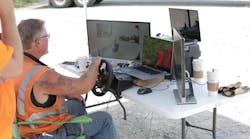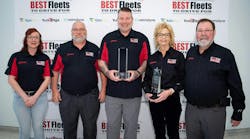Stefan Seltz-Axmacher knows that many drivers don't like him and his autonomous trucks so he tries to change the conversation. "Yes, we're these nerdy guys from San Francisco, and we've built a robot that looks like it does their work," says the CEO and co-founder of Starsky Robotics. "Drivers say, 'Oh, my gosh. Are they going to take our jobs?' but when the conversation becomes about remote driving, and more home time, we go from being an enemy to a friend. I really hope that's the dynamic we're largely able to have."
The company's goal is to retrofit trucks with radar, cameras and all the other gadgets that have proven their worth in point-to-point superslab trials like Otto hauling beer. But it's the 'last mile' that makes the difference. Currently, autonomous trucks need a driver in the seat to negotiate the more complex trips to-and-from the interstates, and that's where Starsky Robotics is changing the rules.
Instead of requiring a person in the seat, the truck will be piloted by remote control by a CDL driver who could be many miles away. Like a military drone operator or video gamer with a driving console, the remote driver will see everything a driver in the cab would see and operate the same controls including steering wheel, brakes and accelerator. Most of the equipment is 'off-the-shelf' and therefore not expensive.
Seltz-Axmacher suggests that one driver could control 20 to 30 different trucks to and from the highway. "Let's say that Phil gets Truck #1 at 9 a.m. at the terminal at the start of his shift and that takes about 20 minutes. At 9:20, he gets Truck #2 from the terminal to the highway; that's 20 minutes. Then truck #3. Once they get to the highway, they're all driving themselves," he says.
You could get local drivers, pay them what they might earn now, but they stay near their home, he says. How close are they to making this work? "The goal in the next couple of months is to have regular service, where on a consistent basis robot-driven trucks are hauling freight on the highway. Safety drivers will still be in the truck, but by the end of this year the safety driver will be out of the vehicle."
As for the cost, Seltz-Axmacher's noted: "We will be charging the same as if a carrier hired a driver. Rather than do a whole of recruiting work to get a driver and then pay them 45 cents a mile, you would pay us 45 cents a mile and then your truck can drive 23-1/2 hours a day, and we don't quit."
The company is focusing its efforts on highways in Michigan, Florida and Nevada because their laws and regulations are more sympathetic to autonomous truck testing.
President Trump's newly-appointed Department of Transportation Secretary Elaine Chao wants to speed up implementation of autonomous trucks. Speaking at the National Governor's Winter Conference in November she said that the president is interested in advancing autonomous vehicles and removing regulations put in place by the Obama administration.
The Obama guidelines called on autonomous technology companies to adhere to a voluntary 15-point safety assessment. However, when the regulations were implemented, autonomous vehicle companies complained that they were too restrictive and would delay testing and slow down implementation.
Chao told the governors: “This administration is evaluating this guidance (the Obama guidelines) and will consult with you and other stakeholders as we update it and amend it, to ensure that it strikes the right balance.” About the loss of trucking driving jobs she said: "As a former secretary of Labor, I am very, very concerned about that and very cognizant of those challenges. So we do have to transition people, and we need to keep that in mind.”




